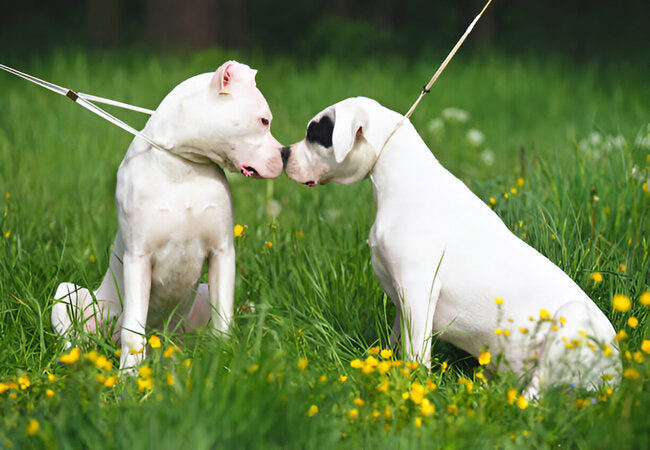What to Do About Dog Bullies & Dogs Who Bully Others — Vet Guide 2025 ✅🐶⚖️

In this article
What to Do About Dog Bullies & Dogs Who Bully Others—Vet Guide 2025 🐶⚖️
By Dr. Duncan Houston BVSc
When one dog consistently dominates, pins, or ignores another’s clear “stop” signals, what you’re likely seeing is canine bullying. In 2025, veterinary experts define dog bullying as persistent, one-sided behavior that causes stress or harm to another dog. Left unaddressed, it can lead to anxiety, aggression, injury—even veterinary exclusion from daycare or parks. This article equips you with the knowledge and strategies to correct, prevent, and redirect bullying behaviors humanely and effectively.
1. Spotting the Signs of a Bully Dog 🕵️♀️
Bullying is more than playful roughhousing. Red flags include:
- One-sided chasing or pinning: Dog A always chases or pins Dog B.
- Ignoring social cues: Continues after muzzle tucks, lip-licks, yawns, retreat.
- Resource guarding: Stealing toys, food bowls, or pushing others away.
- Mounting or stiff posturing: Asserting dominance rather than mating.
- Stress in other dogs: Retreating, yelping, avoidance—signals that another dog is overwhelmed.
2. Early Intervention Is Key 🚨
Don’t wait for it to escalate. Prompt management helps prevent long-term anxiety and complex behavior issues. Remove the bully from the situation calmly when bullying starts.
3. Time‑outs & Negative Punishment
Use “time-outs” as a clear consequence:
- Immediately say a neutral cue like “Oops!” or “Time‑out.”
- Leash or remove your dog for at least 20–30 seconds.
- Allow return only when calm—never as a reward.
This “negative punishment” teaches that bullying pauses the fun.
4. Limit Play Partner & Environment Choices
Select calm, well-matched playmates. Avoid big group settings where the bully feels emboldened. Consider structured one-on-one playdates instead of free-for-all dog parks.
5. Build Impulse Control & Reinforce Good Behavior
Train calm behaviors:
- Recall, “sit,” “leave it” with distractions present.
- Praise and reward self-control in the presence of other dogs.
- Regular training sessions reduce pent-up energy that fuels bullying.
6. Provide Exercise & Mental Enrichment
Understimulated dogs act out. Offer daily walk, puzzle toys, fetch, scent games, obedience drills—these meet your dog’s physical and mental needs, reducing bullying motivation.
7. Socialization from Early Age
Puppies exposed to diverse, gentle play learn cooperative social skills. Delayed or poor socialization increases risk of bullying in adulthood.
8. Watch for Patterns & Triggers
Observe if bullying increases:
- Around new dogs or toys?
- After high-energy exercise?
- When tired or overstimulated?
Adjust setting accordingly, avoiding triggers when possible.
9. Supervise & Reinforce Appropriate Play
Careful supervision allows you to step in early. Use redirection and praise cooperative play:
- Redirect chase with toy or recall.
- Intervene if one dog appears overwhelmed—end session.
- Celebrate calm, balanced interactions immediately.
10. When Professional Help Is Needed
If bullying persists despite consistent training, it’s time for a certified behaviorist. They’ll assess triggers, dog’s history, and craft a personalized plan—which may involve training, behavior adjustment, anxiety management, or structured group exposures.
Community Advice from Reddit
> “Stay outside the fence and work on training your dog to focus on you with the distraction of other dogs… If your dog is aggressively bullying… they don’t belong in group situations.”
2025 Owner Action Plan 📋
- 🕵️♂️ Recognize domination vs. friendly play.
- ⏱ Use time-outs at first sign of bullying.
- 🎯 Reinforce calm behaviors with treats & praise.
- 👥 Choose appropriate playmates & settings.
- 🤸 Provide mental and physical enrichment daily.
- 📅 Track escalation patterns and triggers.
- 👨🏫 Consult trainer/behaviorist for persistent cases.
FAQs 💬
• Is bullying just “rough play”?
No—bullying causes stress, ignores signals, and isn’t reciprocal. If one dog is overwhelmed, it’s bullying.
• Can bullying lead to fights?
Yes—long-term intimidation builds tension that may erupt into aggressive behavior.
• How long does it take to change bullying?
With consistency, some improvement is seen in weeks—but full social adjustment may take months, especially in older dogs.
• Should I stop taking my dog to dog parks?
If your dog can't control impulses or bullies persistently, skip uncontrolled environments until trained. One-on-one play is safer.
Conclusion ❤️
Dog-on-dog bullying compromises both happiness and safety. In 2025, vets and behaviorists advocate for proactive, gentle interventions: clear time-outs, structured play, impulse training, and enrichment. When professional help is needed, Seek a certified behaviorist for tailored support. With consistency and empathy, your dog can learn respectful social interactions and thrive in community. 🐕
Need help now? Visit AskAVet.com or download the Ask A Vet app to track behavior, connect with experts, and build a peaceful pack life.






